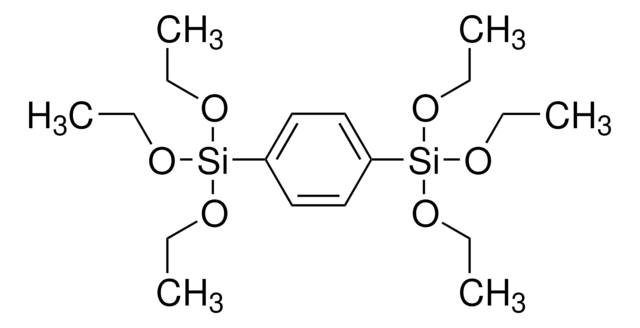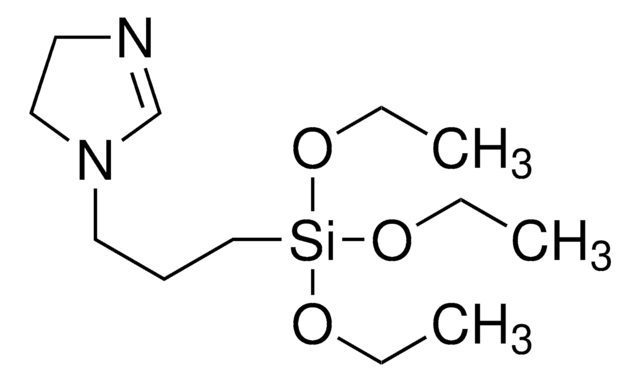638102
4,4′-Bis(triethoxysilyl)-1,1′-biphenyl
≥90% (VPCC)
Sinonimo/i:
4,4′-Bis(triethoxysilyl)biphenyl
About This Item
Prodotti consigliati
Saggio
≥90% (VPCC)
P. eboll.
203-206 °C/0.3 mmHg (lit.)
Densità
1.047 g/mL at 25 °C (lit.)
Stringa SMILE
CCO[Si](OCC)(OCC)c1ccc(cc1)-c2ccc(cc2)[Si](OCC)(OCC)OCC
InChI
1S/C24H38O6Si2/c1-7-25-31(26-8-2,27-9-3)23-17-13-21(14-18-23)22-15-19-24(20-16-22)32(28-10-4,29-11-5)30-12-6/h13-20H,7-12H2,1-6H3
KENDGHJJHKCUNB-UHFFFAOYSA-N
Categorie correlate
Applicazioni
BTESB can also be utilized as a precursor to prepare:
- Helical 4, 4′-biphenylene-silica nanotubes and nanoribbons using 3-aminopropyltrimethoxysilane as a co-structure-directing agent.
- Biphenyl-bridged alkoxysilane-based crosslinked polyalkoxysilane by condensation with linear aliphatic diols.
- Biphenylene-bridged silsesquioxane thin films by the sol-gel method.
Indicazioni di pericolo
Classi di pericolo
Aquatic Chronic 4
Codice della classe di stoccaggio
10 - Combustible liquids
Classe di pericolosità dell'acqua (WGK)
WGK 3
Punto d’infiammabilità (°F)
>230.0 °F - closed cup
Punto d’infiammabilità (°C)
> 110 °C - closed cup
Dispositivi di protezione individuale
Eyeshields, Gloves, multi-purpose combination respirator cartridge (US)
Certificati d'analisi (COA)
Cerca il Certificati d'analisi (COA) digitando il numero di lotto/batch corrispondente. I numeri di lotto o di batch sono stampati sull'etichetta dei prodotti dopo la parola ‘Lotto’ o ‘Batch’.
Possiedi già questo prodotto?
I documenti relativi ai prodotti acquistati recentemente sono disponibili nell’Archivio dei documenti.
I clienti hanno visto anche
Il team dei nostri ricercatori vanta grande esperienza in tutte le aree della ricerca quali Life Science, scienza dei materiali, sintesi chimica, cromatografia, discipline analitiche, ecc..
Contatta l'Assistenza Tecnica.


![Bis[3-(triethoxysilyl)propyl] tetrasulfide technical, ≥90% (NMR)](/deepweb/assets/sigmaaldrich/product/structures/242/790/625f5cba-32bd-4acf-a3be-e119e9cf844f/640/625f5cba-32bd-4acf-a3be-e119e9cf844f.png)









